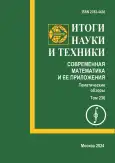Итоги науки и техники. Современная математика и её приложения. Тематические обзоры
Научный рецензируемый журнал, издаваемый с 1995 г. Отделом научной информации по фундаментальной и прикладной математике Всероссийского института научной и технической информации Российской академии наук (ВИНИТИ РАН).
Свидетельство о регистрации СМИ: ЭЛ № ФС 77 - 82877 от 25.02.2022
Журнал публикует исследовательские и обзорные статьи по всем разделам современной математики: алгебре, топологии, теории чисел, математической логике, дифференциальной геометрии, функциональному анализу, теории вероятностей, вещественному и комплексному анализу, асимптотическим методам, обыкновенным дифференциальным уравнениям и уравнениям с частными производными, математической физике, а также по прикладным аспектам математики и её приложениям в естественных и технических науках.
Русская версия выпусков журнала выходит в свет в электронном виде и публикуется на сайтах ВИНИТИ РАН, Общероссийском математическом портале MathNet.ru и в Научной электронной библиотеке eLibrary.ru.
Все выпуски реферируются и индексируются следующими базами данных: Реферативный журнал «Математика» ВИНИТИ РАН, РИНЦ (eLibrary), Mathematical Reviews. Издание в полном объеме переводится на английский язык издательством Springer Nature в журнале Journal of Mathematical Sciences, который реферируется в базе данных SCOPUS.
Главный редактор
Гамкрелидзе Реваз Валерианович, академик РАН, д-р физ.-мат. наук, профессор
Периодичность / доступ
12 выпусков в год / открытый
Текущий выпуск
Том 236 (2024)
Статьи
Об одном подходе к сильному решению B-эллиптической краевой задачи и его разностном приближении
Аннотация
Работа посвящена построению разностной схемы для краевой задачи с уравнением B-эллиптического типа. Исследование сходимости ведется в весовом пространстве Киприянова. С помощью усредняющих операторов Стеклова выведено интегральное соотношение баланса, которому удовлетворяет точное решение исходной задачи. Получена пятиточечная разностная схема и априорная оценка погрешности.
 3-12
3-12


О функционировании ресурсных сетей
Аннотация
Ресурсные сети — динамические графовые модели, введенные в рассмотрение О. П. Кузнецовым и Л. Ю. Жиляковой. В основе модели лежат правила их функционирования. В работе предложен общий подход к определению функционирования ресурсных сетей, состоящий в задании на дугах ресурсной сети функции приоритетности, которая и определяет правила функционирования ресурсной сети. Ресурсные сети Кузнецова—Жиляковой являются частным случаем ресурсных сетей с приоритетами на дугах, когда все дуги имеют одинаковые приоритеты. Приведены примеры, показывающие, что ресурсные сети, имеющие одинаковую топологию, при разных функциях приоритетности функционируют по-разному. Получены критерии возникновения стационарного функционирования ресурсной сети с приоритетами на дугах, главным из которых является условие сбалансированности потока. Наиболее общим расширением понятия ресурсной сети является приведенное в работе определение ресурсной сети с динамическими приоритетами на дугах. В этом случае функция приоритетности, заданная на дугах сети, зависит от дискретного времени, в котором функционирует сеть.
 13-21
13-21


Вклад обобщенной техники бохнера в геометрию полных минимальных подмногообразий
Аннотация
На основе методов техники Бохнера, являющейся важной частью геометрического анализа, установлены условия, при которых минимальные и устойчивые минимальные подмногообразия в римановых многообразиях характеризуются как вполне геодезические подмногообразия.
 22-30
22-30


Структура существенного спектра и дискретный спектр оператора энергии шестиэлектронных систем в модели Хаббарда. Четвертое триплетное состояние
Аннотация
Рассматривается оператор энергии шестиэлектронных систем в модели Хаббарда и исследуются структура существенного спектра и дискретный спектр системы для четвертого триплетного состояния системы. Доказано, что в одномерном и двумерном случаях существенный спектр оператора шестиэлектронного четвертого триплета является объединением семи отрезков, а дискретный спектр системы содержит не более одного собственного значения. В трехмерном случае имеют место следующие ситуации: (а) существенный спектр оператора шестиэлектронного четвертого триплета является объединением семи отрезков, а дискретный спектр содержит не более одного собственного значения; (б) существенный спектр является объединением четырех отрезков, а дискретный спектр пуст; (в) существенный спектр является объединением двух отрезков, а дискретный спектр пуст; (г) существенный спектр состоит из единственного отрезка, а дискретный спектр пуст. Найдены условия, при которых реализуется каждая ситуация.
 31-48
31-48


Расщепляющее преобразование линейной нестационарной сингулярно возмущенной системы с постоянным запаздыванием в уравнении медленной переменной
Аннотация
Для линейной нестационарной сингулярно возмущенной системы с постоянным за-паздыванием в уравнении для медленных переменных на основе алгебраического подхода — погружения системы с запаздыванием в семейство систем с расширенным пространством состояний — и нелокальной замены переменных разработан метод декомпозиции по темпам изменения переменных. Доказано существование и построена асимптотика преобразования Ляпунова, обобщающего на системы с запаздыванием расщепляющее преобразование Чанга и осуществляющего полную декомпозицию двухтемповой системы с постоянным запаздыванием на две независимые подсистемы меньших размеров, чем исходная: отдельно по быстрой и медленной переменным. Доказано, что расщепленная система алгебраически и асимптотически эквивалентна исходной системе в расширенном пространстве состояний. Построена асимптотика и исследовано действие асимптотических аппроксимаций расщепляющего преобразования.
 49-71
49-71


Инварианты однородных динамических систем произвольного нечетного порядка с диссипацией. I. Системы третьего порядка
Аннотация
Представлены примеры интегрируемых однородных по части переменных динамических систем третьего порядка, в которых может быть выделена система на касательном расслоении к двумерному многообразию. При этом силовое поле разделяется на внутреннее (консервативное) и внешнее, которое обладает диссипацией разного знака. Внешнее поле вводится с помощью некоторого унимодулярного преобразования и обобщает ранее рассмотренные поля. Приведены полные наборы как первых интегралов, так и инвариантных дифференциальных форм.
 72-88
72-88








